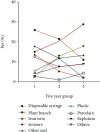Clinical Characteristics, Treatment, and Visual Prognosis in Pediatric Endophthalmitis: A 232-Case Retrospective Study
- PMID: 38469036
- PMCID: PMC10927339
- DOI: 10.1155/2022/8523747
Clinical Characteristics, Treatment, and Visual Prognosis in Pediatric Endophthalmitis: A 232-Case Retrospective Study
Abstract
Objective: In infective endophthalmitis, once the patient's vision is seriously damaged, the damage to children's vision is particularly serious. The main purpose of this study is to investigate the etiology, epidemiology, treatment, and visual prognosis of children's endophthalmitis and to conduct an in-depth analysis. Study Design. This study collected case data from the Beijing Tongren Hospital Capital Medical University in the period from January 1, 2002 to January 1, 2018. The basic conditions for inclusion in the collection range were patients who were less than or equal to 14 years old and had a history of infectious endophthalmitis. A retrospective study and analysis of etiology, epidemiology, treatment, and visual prognosis were performed. Kappa and Chi square test were used for statistical analysis.
Results: A total of 232 cases were collected, with an average age of 6.33 ± 2.89 years (range 8months to 14 years). The most common etiologies were ocular trauma (93.5%) and previous ocular surgery (5.2%). Overall, 81 samples were sent to the microbiology department for direct smear and culture, from which 21 organisms were isolated. 28 cases (39.5%) were culture-positive. The most organism was Gram-positive organisms. In treatment, the proportion of PPV use combined with silicone oil filling had increased gradually in three phases, while the other treatments were almost decreased or nearly similar. The final visual result is 22 (9.5) in 20/200 or better, 65 (28.0) in CF-20/200, 38 (16.4) in hand move (HM), 27 (11.6) in light perception (LP), 21 (9.1) in no light perception (NLP), and 59 (25.4) did not match (NM).
Conclusion: Penetrating ocular trauma is the most common cause of infectious endophthalmitis in children. The detection rate of microorganisms is low and helpless for the treatment. In this study, it was found that despite the aggressive treatments such as antibacterial and vitrectomy, the ultimate improvement in vision was highly undesirable.
Copyright © 2022 Fantao Lv et al.
Conflict of interest statement
The authors declared no conflict of interest.
Figures






Similar articles
-
Pediatric Infectious Endophthalmitis: A 271-case Retrospective Study at a Single Center in China.Chin Med J (Engl). 2016 Dec 20;129(24):2936-2943. doi: 10.4103/0366-6999.195473. Chin Med J (Engl). 2016. PMID: 27958225 Free PMC article.
-
Open globe injuries with positive intraocular cultures: factors influencing final visual acuity outcomes.Ophthalmology. 2003 Aug;110(8):1560-6. doi: 10.1016/S0161-6420(03)00497-4. Ophthalmology. 2003. PMID: 12917173
-
Vitrectomy combined with silicone oil tamponade in the treatment of severely traumatized eyes with the visual acuity of no light perception.Int J Ophthalmol. 2013 Apr 18;6(2):198-203. doi: 10.3980/j.issn.2222-3959.2013.02.18. Print 2013. Int J Ophthalmol. 2013. PMID: 23638424 Free PMC article.
-
Endophthalmitis after pars plana vitrectomy. The Postvitrectomy Endophthalmitis Study Group.Ophthalmology. 1995 May;102(5):705-12. doi: 10.1016/s0161-6420(95)30965-7. Ophthalmology. 1995. PMID: 7777268 Review.
-
Endogenous bacterial endophthalmitis: an east Asian experience and a reappraisal of a severe ocular affliction.Ophthalmology. 2000 Aug;107(8):1483-91. doi: 10.1016/s0161-6420(00)00216-5. Ophthalmology. 2000. PMID: 10919895 Review.
Cited by
-
Retracted: Clinical Characteristics, Treatment, and Visual Prognosis in Pediatric Endophthalmitis: A 232-Case Retrospective Study.Appl Bionics Biomech. 2023 Aug 16;2023:9817126. doi: 10.1155/2023/9817126. eCollection 2023. Appl Bionics Biomech. 2023. PMID: 37621469 Free PMC article.
References
-
- Weinstein G. S., Mondino B. J., Weinberg R. J., Biglan A. W. Endophthalmitis in a pediatric population. Annals of Ophthalmology . 1979;11(6):935–943. - PubMed
LinkOut - more resources
Full Text Sources

